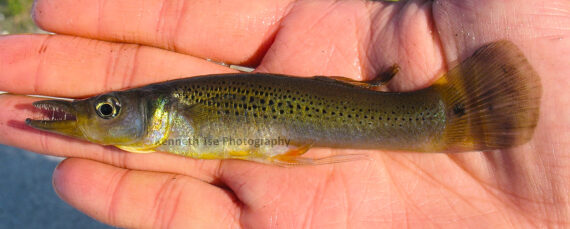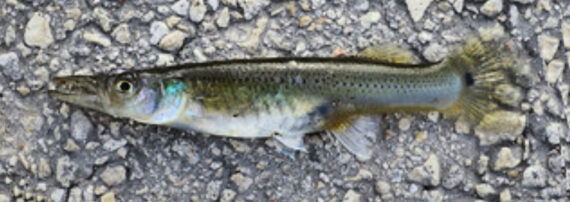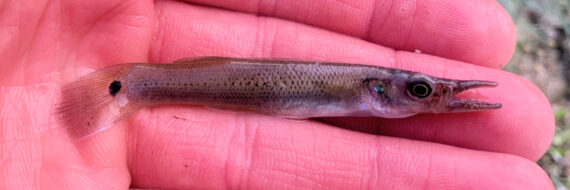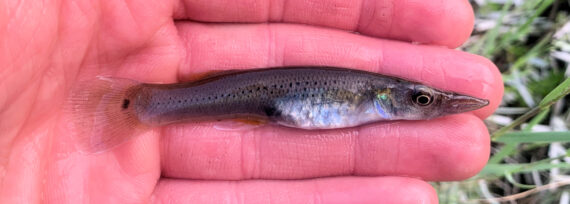Pike Killifish, Belonesox belizanus
 Pike Killifish, Belonesox belizanus. Fish caught from a drainage canal in Homestead, Florida, April 2015. Length: 12.7 cm (5.0 inches). Catch, photograph, and identification courtesy of Kenneth Tse, Toronto, Canada.
Pike Killifish, Belonesox belizanus. Fish caught from a drainage canal in Homestead, Florida, April 2015. Length: 12.7 cm (5.0 inches). Catch, photograph, and identification courtesy of Kenneth Tse, Toronto, Canada.
 Pike Killifish, Belonesox belizanus. Fish caught from a drainage canal in Homestead, Florida, April 2015. Length: 12.7 cm (5.0 inches). Catch, photograph and identification courtesy of Eli (obsessiveangling.wordpress.com).
Pike Killifish, Belonesox belizanus. Fish caught from a drainage canal in Homestead, Florida, April 2015. Length: 12.7 cm (5.0 inches). Catch, photograph and identification courtesy of Eli (obsessiveangling.wordpress.com).

 Pike Killifish, Belonesox belizanus. Fish caught from a drainage canal in Homestead, Florida, August 2019. Length: 12.7 cm (5.0 inches). Catch, photograph and identification courtesy of Luke Ovgard, Klamath Falls, Oregon.
Pike Killifish, Belonesox belizanus. Fish caught from a drainage canal in Homestead, Florida, August 2019. Length: 12.7 cm (5.0 inches). Catch, photograph and identification courtesy of Luke Ovgard, Klamath Falls, Oregon.
The Pike Killifish, Belonesox belizanus, is a member of the Livebearer or Poeciliidae Family, that is also known as the Pike Liverbearer and the Top Minnow and in Mexico as picudito. This is the only species in the genus Belonesox and in Mexico it is found the freshwater systems that drain into the Atlantic Ocean.
The Pike Killifish has a slender elongated body with a flat upper profile. They are light olive-brown dorsally and transition to lighter yellowish-white ventrally. They have small black spots on a light green iridescent background on their flanks and a dark spot at their caudal fin base. Females can be distinguished from males by a red spot on their anal fin and by a diminished tail spot. Juveniles have a dark lateral stripe that is believed to help with camouflage. Their head has a distinctly elongated snout, large eyes, a pointed beak, and a longer upturned lower jaw. They are equipped with large teeth. Their dorsal fin is set well back on the body behind the anal fin. They are covered with numerous small scales.
The Pike Killifish is found near the surface in a wide variety of freshwater and brackish habitats including weedy canals, slow flowing rivers, ponds, and lakes with low oxygen content, large amounts of aquatic vegetation, high salinities, and temperatures ranging from 25oC (77oF) and 37oC (98oF). They are dimorphic with females reaching 20.0 cm (7.9 inches) in length whereas males reaching 10.0 cm (3.9 inches). They are ambush predators with unique predatory skills; their extremely flexible upper jaw allows them to consume very large prey for their size including small fish such as mosquitofish and mollies. In turn they are preyed upon by various shore bird, fish, invertebrates and reptiles. Reproduction is ovoviviparous with internal fertilization. Females have the ability to store sperm for later use and release multiple batches of up to 320 live young year-round, which measure 2.5 cm (1.0 inch) in length and are born as self-sufficient miniature adults. They have a lifespan of at least five years. The Pike Killifish is poorly studied with very limited information available about their lifestyle and behavioral patterns including specific details on age, growth, longevity, movement patterns, diet, habitat use, and reproduction.
The Pike Killifish are found in all freshwater systems of Mexico that drain into the Gulf of Mexico. They have been introduced into the freshwater systems of southern Florida where they have become highly invasive and widely established.
Due to its appearance, the Pike Killifish cannot be easily confused with any other species.
From a conservation perspective the Pike Killifish is currently considered to be of Least Concern with stable, widely distributed populations. They are a minor and unpopular component of the aquarium trade as they are difficult to manage as they require large tanks, are finicky eaters requiring special diets including live fish, consume tank mates, and practice cannibalism on their young. They have become highly invasive in some areas of introduction as they are prolific breeders. They have also reduced native populations of the Eastern Mosquitofish, Gambusia holbrooki, and other native cyprinodontoid and poeciliids, and also compete for food with juvenile snooks.